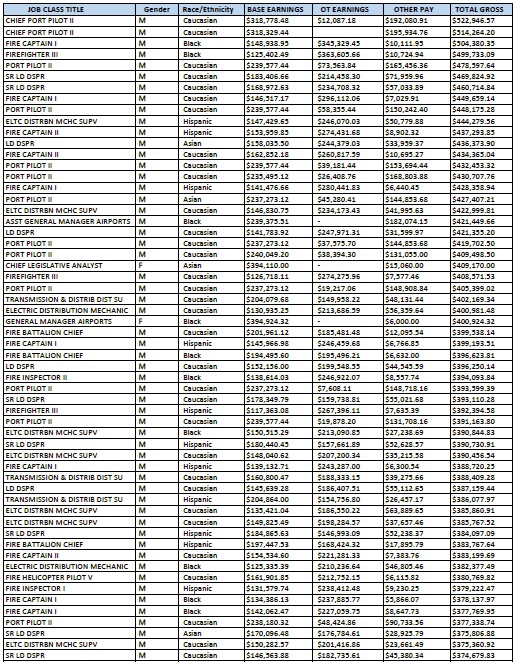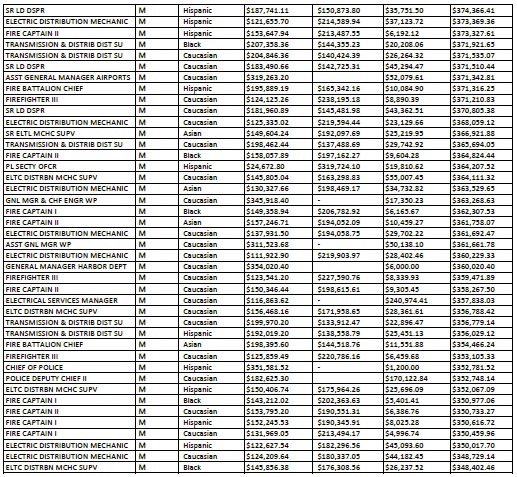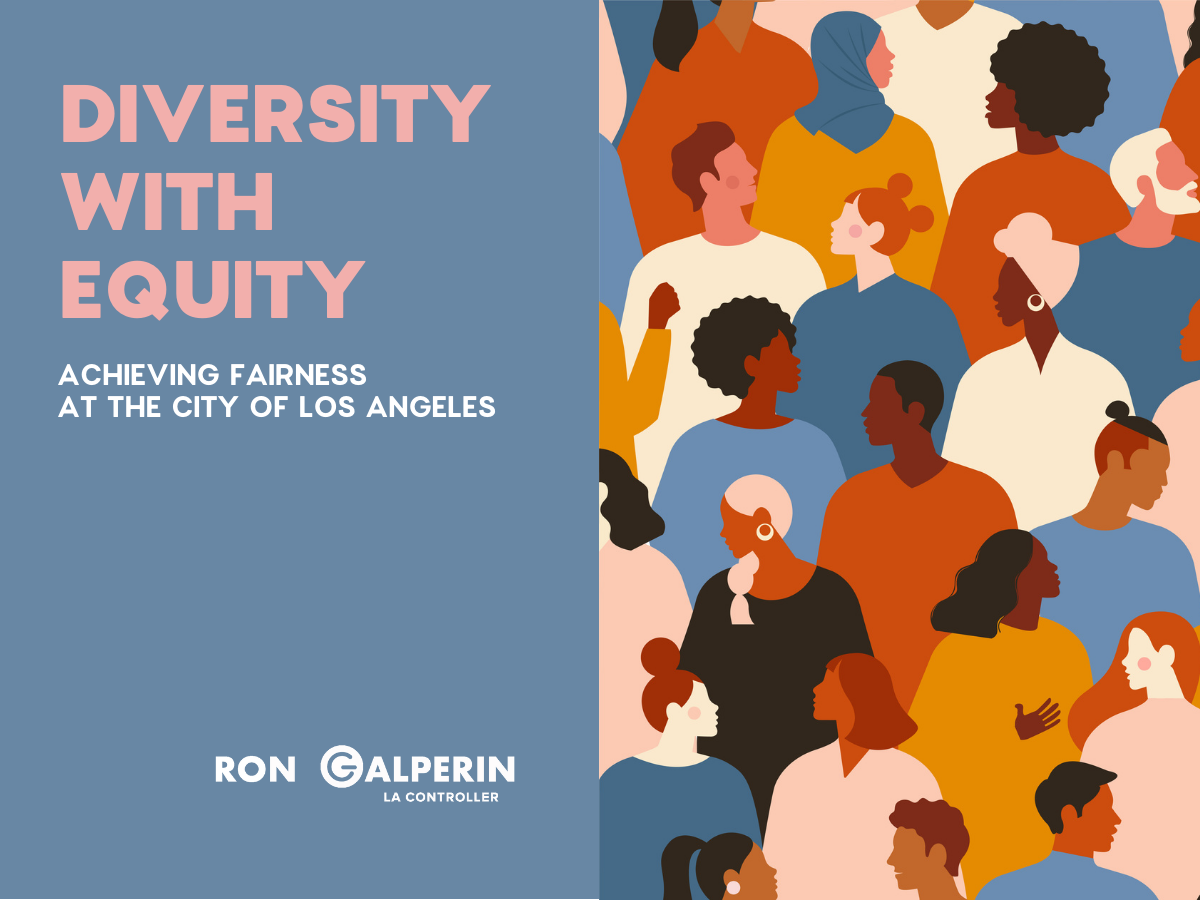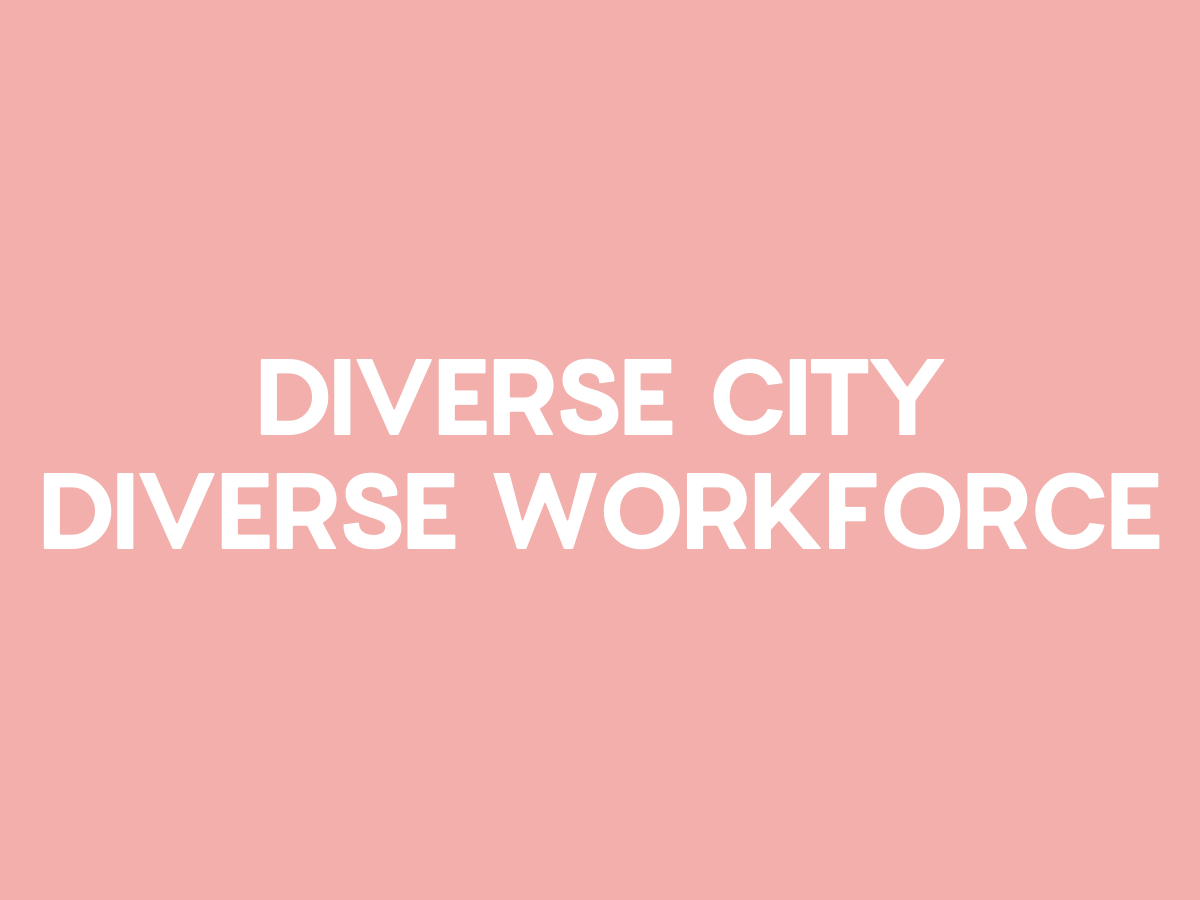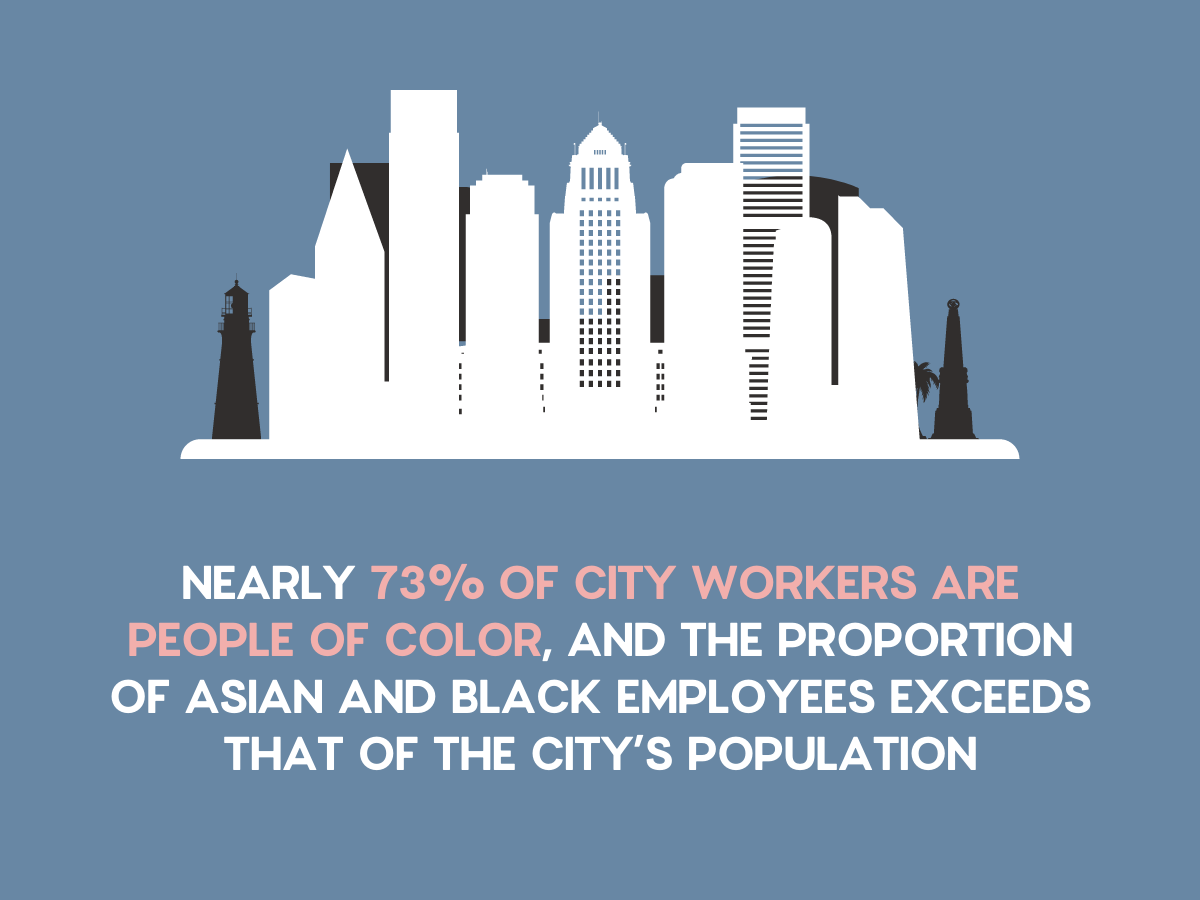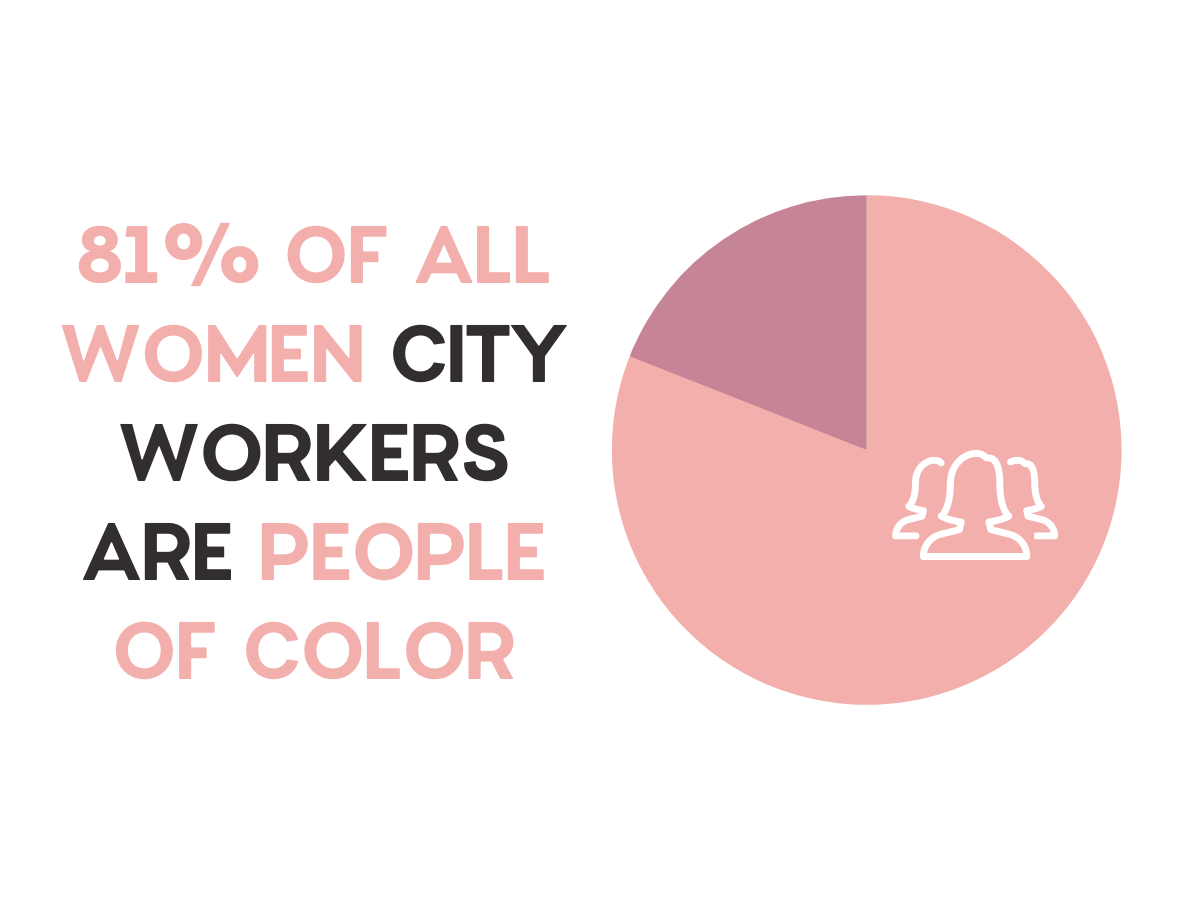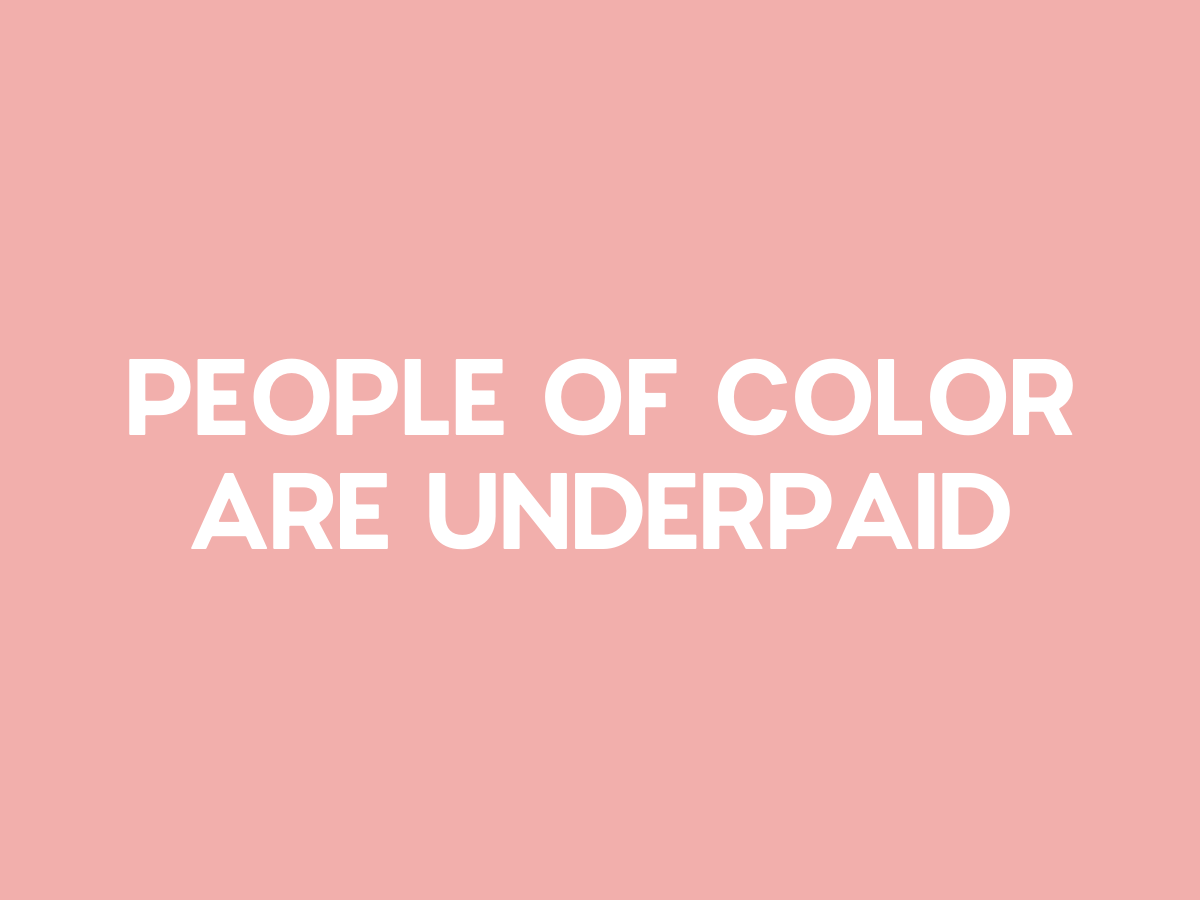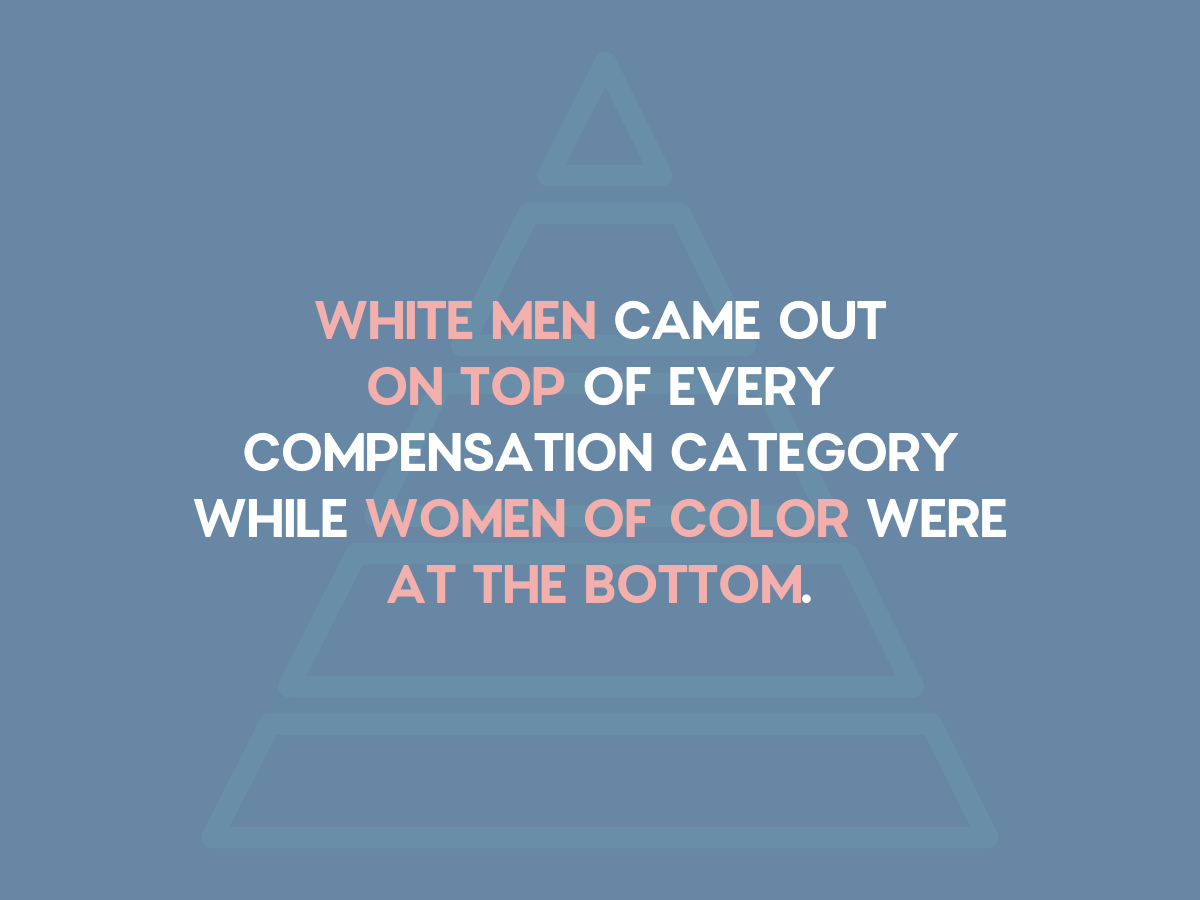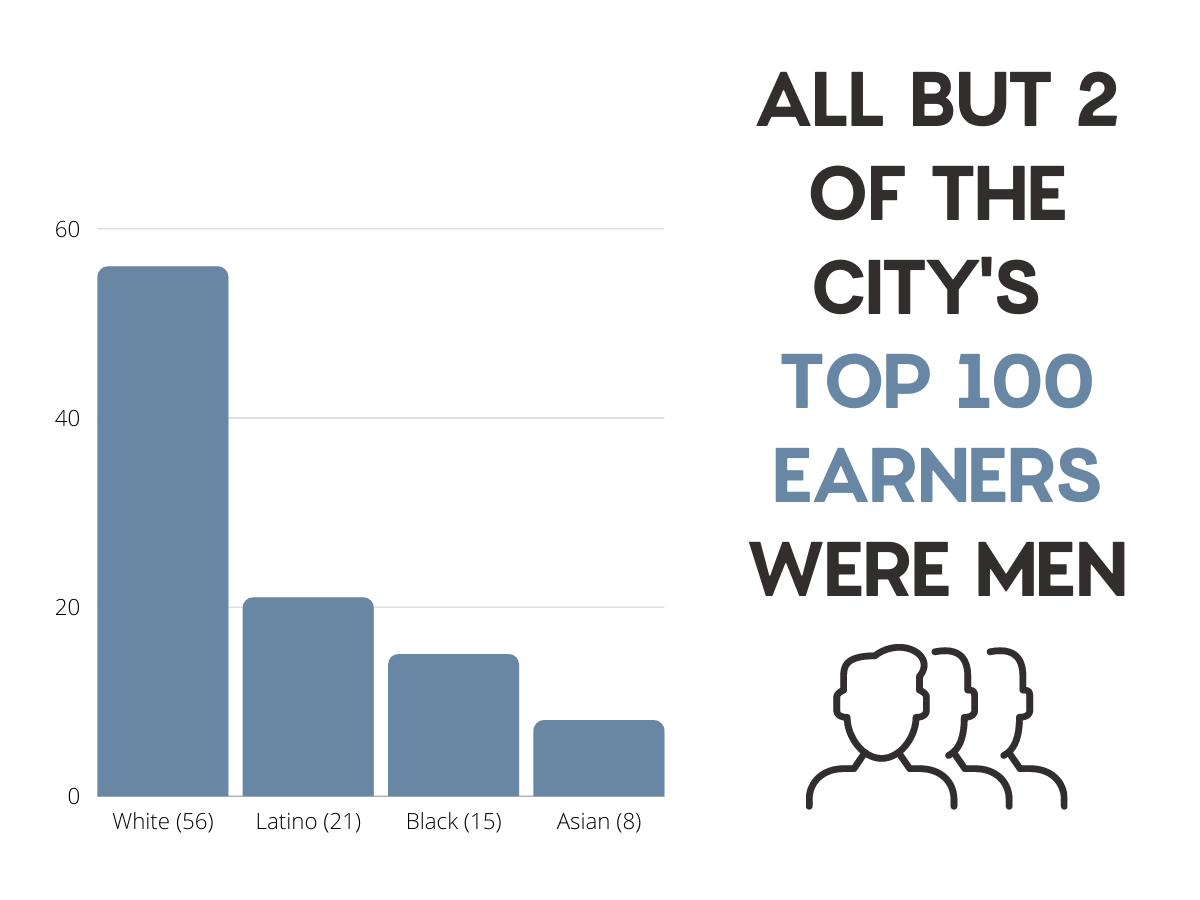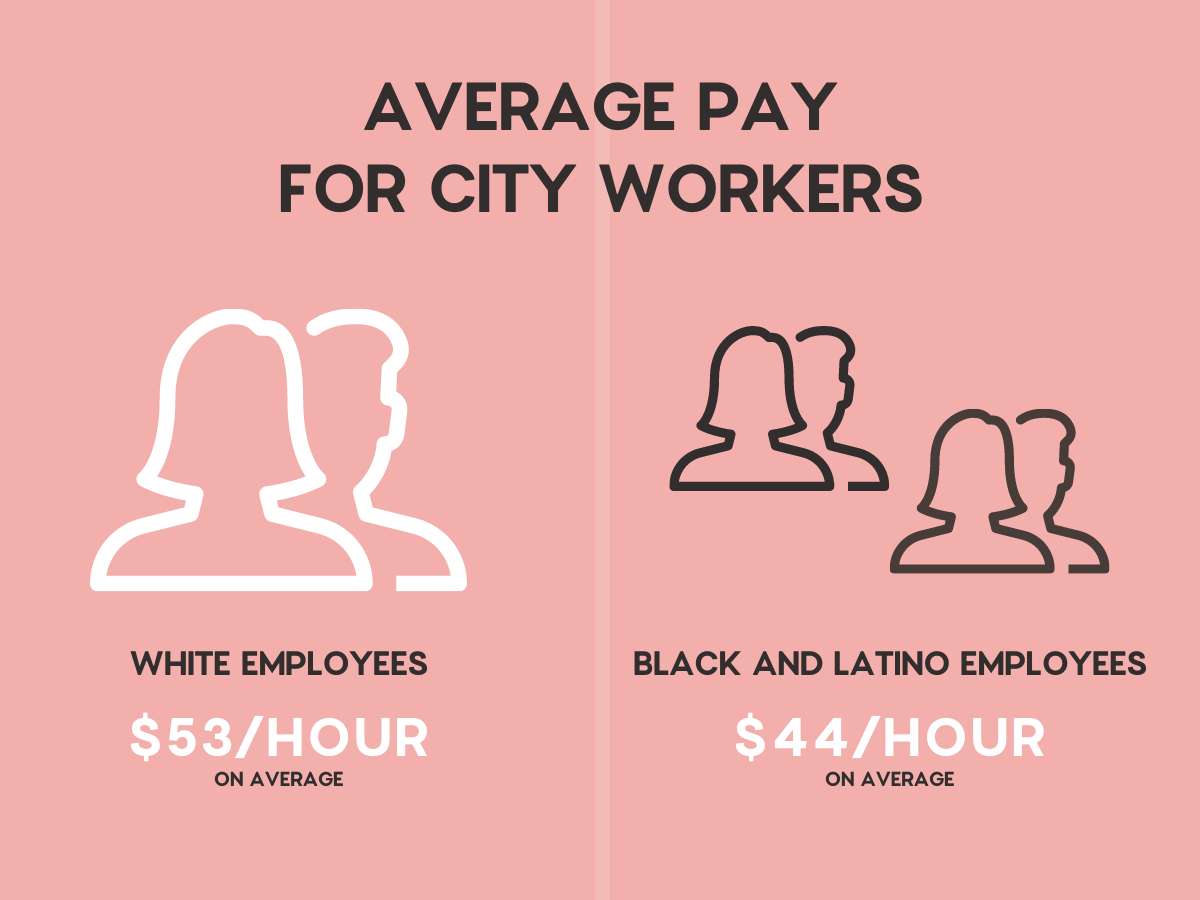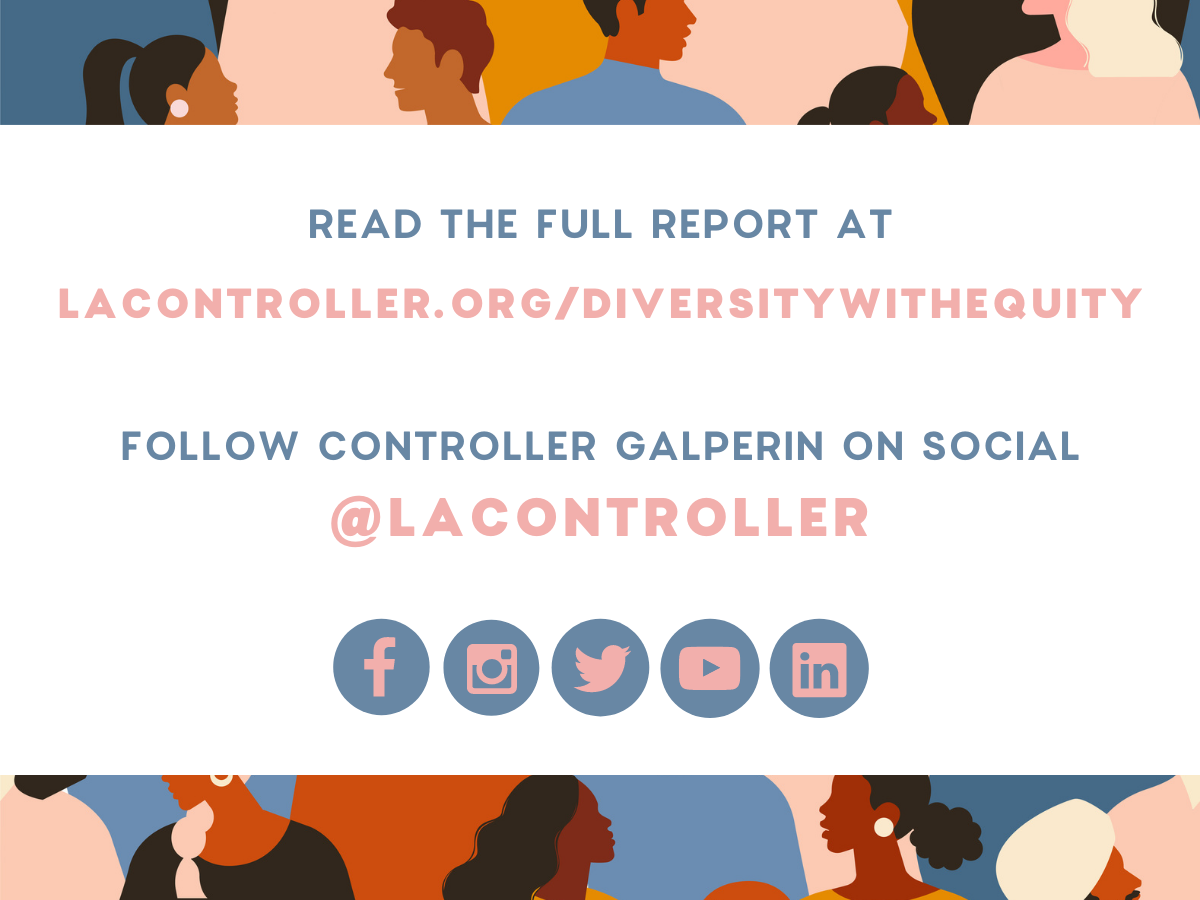Diversity with Equity: Achieving Fairness at the City of Los Angeles
2021 City of Los Angeles
Los Angeles is one of the most diverse cities in America, yet not one of the most equitable. Too many residents lack access to the opportunities our region has to offer. Local government should champion fairness both in word and deed, including with its own workforce. L.A.’s leaders have taken action to achieve a more level playing field, but more is needed. This report addresses inequity among City employees of different ethnic backgrounds, specifically pointing out the lower pay earned by employees of color.
Use the dashboard below explore makeup of the City’s workforce by ethnicity, gender, years of service and pay rate. Click on the tabs at the top to view a dropdown menu where you can filter visualizations by department, city function, job class or sworn status. The information displayed is based on Fiscal Year 2020 payroll data.
Each bar below contains a section of the report. Click on any to expand and read the full text of the section. Click again to collapse.
February 3, 2021
Honorable Eric Garcetti, Mayor
Honorable Michael Feuer, City Attorney
Honorable Members of the Los Angeles City Council
Re: Diversity with Equity: Achieving Fairness at the City of Los Angeles
Los Angeles is often referred to as one of the most diverse cities in America and, in many ways, it is. Large numbers of people of different races, ethnicities and cultures live here; myriad religions and ideologies flourish; residents of all sexual orientations and gender identities populate our neighborhoods. These are just some of the ways Angelenos differ, and those differences create a multilayered mosaic around us. Different people bring with them unique experiences, which are the foundation of new hopes, beliefs and a better collective future.
But, as diverse as it is, Los Angeles is not the most equitable city in America. With surging levels of homelessness, poverty and food insecurity plaguing some neighborhoods and ethnic groups far more than others — only heightened by the ongoing pandemic — too many in our City do not enjoy all the opportunities our region has to offer.
Local government is not immune to the outside influences that shape society, but it can and should champion fairness both in word and deed, including with its own workforce. In recent years, L.A.’s leaders have enacted laws, issued directives and created a department and task force to achieve greater racial and gender diversity and equity.
Last summer, my office pointed to some of these laudable efforts, while also noting how much work remains. In our report, “Closing the Gap: Women’s Pay and Representation at the City of L.A,” the Controller’s Office revealed that women City employees earned 76 percent of what men made and offered recommendations to level the playing field. That report spurred action by the City Council, which is currently working with my office to address these concerns.
My latest report scrutinizes two complimentary issues: diversity and pay inequity among City employees of different ethnicities, specifically pointing out the lower pay earned by employees of color, and women of color most of all.
Pay inequity impacts workers of color
The report details the racial and ethnic composition of the City’s workforce, zeroing in on specific departments. Of the largest, Fire and Building and Safety are among the least diverse, while the Department of Transportation and the Airports Department are among the most. The City’s workforce has become more diverse over time and currently reflects the ethnic composition of L.A. Nearly 73 percent of the workforce are people of color, and the proportion of Asian and Black employees exceeds that of the City’s population. Of note, 81 percent of women City workers are people of color.
As essential as it is, achieving greater diversity alone is not enough to overcome barriers to equity. A payroll analysis found considerable disparities in pay and overtime among different ethnic groups at the City. Caucasian (white) male employees came out on top of every compensation category while women of color were at the bottom.
In Fiscal Year 2020 (FY20), white City workers earned $53 per hour on average, and Black and Hispanic employees earned $44 per hour. Women — especially women of color — earned less than men in all categories. In fact, Black women earned 25% less than the average gross salary for City workers, while white men earned 21% more than the average. All but two of the City’s top 100 earners were men.
Overtime statistics also showed imbalances. The City paid $876 million in overtime over the last fiscal year, with 70% to Hispanic and Caucasian men, mostly sworn employees. Although overtime earnings vary tremendously, the average amount paid to white men was nearly $31,000 — the highest of all ethnic groups — while Asian women earned the least at $7,747.
A fairer City
The City must do more to increase diversity, especially in departments that lag behind, and decrease pay inequity for workers of color. My report makes the following recommendations:
- Support the efforts of the City’s Racial Equity Task Force to develop strategies that increase diversity and address the pay gap for employees of color.
- Use the data in this report to inform Council about the impact of racial inequity in hiring and promotion, and to formulate recommendations on how to fix it.
- Promote transparency by publishing updated demographic information for full-time employees, including workforce diversity data and average pay by race and gender.
I urge City leaders to adopt these recommendations to engender greater equity for L.A.’s employees of color today and for those who will join the City family in the future.
Respectfully submitted,

RON GALPERIN
L.A. Controller
Events of 2020 have pushed the nation and our City to examine the impact of longstanding attitudes and actions about race. This has provided an opportunity to address inequities and work towards eliminating structural racism in our society. The City of Los Angeles is one of the most diverse jurisdictions in America, and as a government institution with more than 50,000 full-time employees, should maintain a workforce that is reflective of the community it serves. Diversity increases employee awareness and fosters respect for differing viewpoints. Thought leaders in Human Resources indicate that diversity in the workplace helps to improve overall productivity, creativity, and performance within an organization.
In August 2020, the Office of the City Controller issued a report entitled “Closing the Gap: Women’s Pay and Representation at the City of L.A”. Based on interest in that report’s findings and additional requests, we conducted a new analysis focused on the racial diversity of the City’s workforce, the subject of this report.
Our analysis found that the City’s workforce, as a whole, closely reflects the racial composition of all Angelenos. Nearly 73% of the City’s workforce are people of color, and the proportion of Asian and Black employees exceeds that of the City’s resident population. Of note, 81% of women working for the City are people of color. Over the last fifteen years, the City has steadily increased its employment of people of color from 65% to the current 73%, and there is greater diversity among the City’s newer employees –those with fewer than five years of City service. A few City Departments lag behind in diversity measures; specifically, Fire, Building & Safety, and the Zoo.
While the City’s total workforce may mirror our community, our analysis found there is significant disparity in hourly pay, gross earnings, and overtime among racial groups. In every compensation category, Caucasian men rank first.
- City employees earn, on average, $48 per hour; however, for Caucasian workers the average rate is $53; while it is about $44 for Black and Hispanic employees. The average hourly rate paid to women is lower than that for men in all race categories.
- Of the top 100 earners in 2019, 56 are Caucasian (all men), while 21 are Hispanic, 15 are Black and 8 are Asian.
- During FY 2020, the City paid $6 billion in gross pay to full-time employees; about 31% of that amount was paid to Caucasians who comprise 27% of the workforce.
- The average gross amount paid to full-time City employees was $112,417. Caucasian men were paid, on average $135,886, which is 21% above the citywide average, while Black women were paid $83,866, or 25% below the average amount.
- The City paid $876 million in overtime, of which 70% went to Hispanic and Caucasian men. Though individuals’ overtime earnings vary tremendously, the average amount earned by Caucasian men was $30,945, the highest of all groups, which is especially notable when compared to Asian women, who averaged $7,747 in overtime earnings.
To support efforts of fairness and diversity, in June 2020 the Mayor created a Racial Equity Task Force and created the Department of Human and Civil Rights. The City should monitor trends related to equity in its workforce and identify ways to promote diversity, especially for higher paid positions. In addition, the City should encourage employee development through training and recognition, and support a healthy work environment that values diversity and does not tolerate discrimination or harassment. The information presented in this report should be used to:
- Support the planned efforts (and those already underway) by the City’s Racial Equity Task Force to develop strategies to increase diversity and achieve compensation equity at all levels of the City workforce.
- Inform the study being conducted by the Chief Equity Officer, the City Administrative Office and the Personnel Department to determine whether there are disparate impacts along the lines of race in hiring, promotion, pay, and access to privilege such as overtime where such impacts are occurring.
- Promote transparency by publicizing demographic information of the City’s full-time employees, including data related to workforce composition and average earnings that considers race and gender. Update and publish this information on an annual basis in order to measure the impact of City efforts to increase diversity and equity.
The City of Los Angeles’ greatest asset is the dedicated workforce that provides critical and needed public services to Angelenos. The City seeks to hire and retain a diverse workforce that is reflective of the community it serves. Events of 2020 have pushed the nation and our City to examine the impact of longstanding attitudes and actions, so we can address inequities and work towards eliminating structural racism in our society and government institutions.
In June 2020, the Mayor created a Department of Human and Civil Rights and issued Executive Directive No. 27, which reiterated that City Departments and Offices shall not discriminate against or grant preferential treatment to, any individual or group on the basis of race, sex, color, ethnicity, or national origin in employment, education, or contracting. To support ongoing efforts of fairness, diversity, equal opportunity, and transparency in the City, each Department and Office was to designate a Racial Equity Officer and develop Racial Equity Plans to identify indicators that could be used track progress towards achieving more racial equity. The Mayor also established a Racial Equity Task Force and directed the Personnel Department to develop and provide mandatory training on implicit bias for all employees.
A statewide ballot initiative presented the possibility of implementing affirmative action policies and programs which could be used by the City in recruitment and procurement decisions; however, Proposition 16 was defeated by the electorate. Nonetheless, policymakers are committed to promoting equity and there are many ways to enhance diversity without affirmative action. Identifying disparities through routine data analyses, developing plans, and measuring results over time, support these efforts.
In August 2020, the Office of the City Controller issued a report entitled “Closing the Gap: Women’s Pay and Representation at the City of L.A”. Based on interest in that report’s findings and additional requests, we conducted a new analysis focused on the racial diversity of the City’s workforce, which is the subject of this report. Similar to the gender analyses, we used the profile data for all full-time City employees and their related earnings as noted by the City’s payroll system.
It is important to note that employees’ self-reported race/ethnicity as noted in the legacy payroll system (PaySR) differs somewhat from U.S. Census data, which clarifies that the concept of race is separate from the concept of Hispanic origin. While PaySR indicates only one of a possible ten categories, the decennial census and related reporting estimates provide data on 14 non-mutually exclusive categories. To simplify comparisons for this report’s presentation on the employee population, we have presented City workforce data aligned as closely as possible with census data, in five primary categories; see the crosswalk below:

Comparative Population Data
As of July 2020, the City of Los Angeles had 50,393 full-time employees. Of these, 19,808 (39%) identify as Hispanic, 13,576 (27%) identify as Caucasian, 7,810 (15%) identify as Black, 7,856 (16%) identify as Asian (including Filipino), and 1,323 (3%) identify as being another ethnicity or is unknown (i.e., 175 American Indian, 839 “other”, 228 “unknown”, 4 Pacific Islander, and 77 “two or more races”).
We used the US Census Bureau’s estimates for Los Angeles City to determine if the City’s full-time workforce mirrors the community we serve. While Caucasian employees and residents are roughly the same percentage, the City workforce has an even greater proportion of Asian and Black individuals than the region’s residents. And while Hispanics may appear to be under-represented on the workforce, it is important to keep in mind that the Hispanic/Latino ethnicity is considered and reported slightly differently by the US Census data as compared to internal City payroll records.
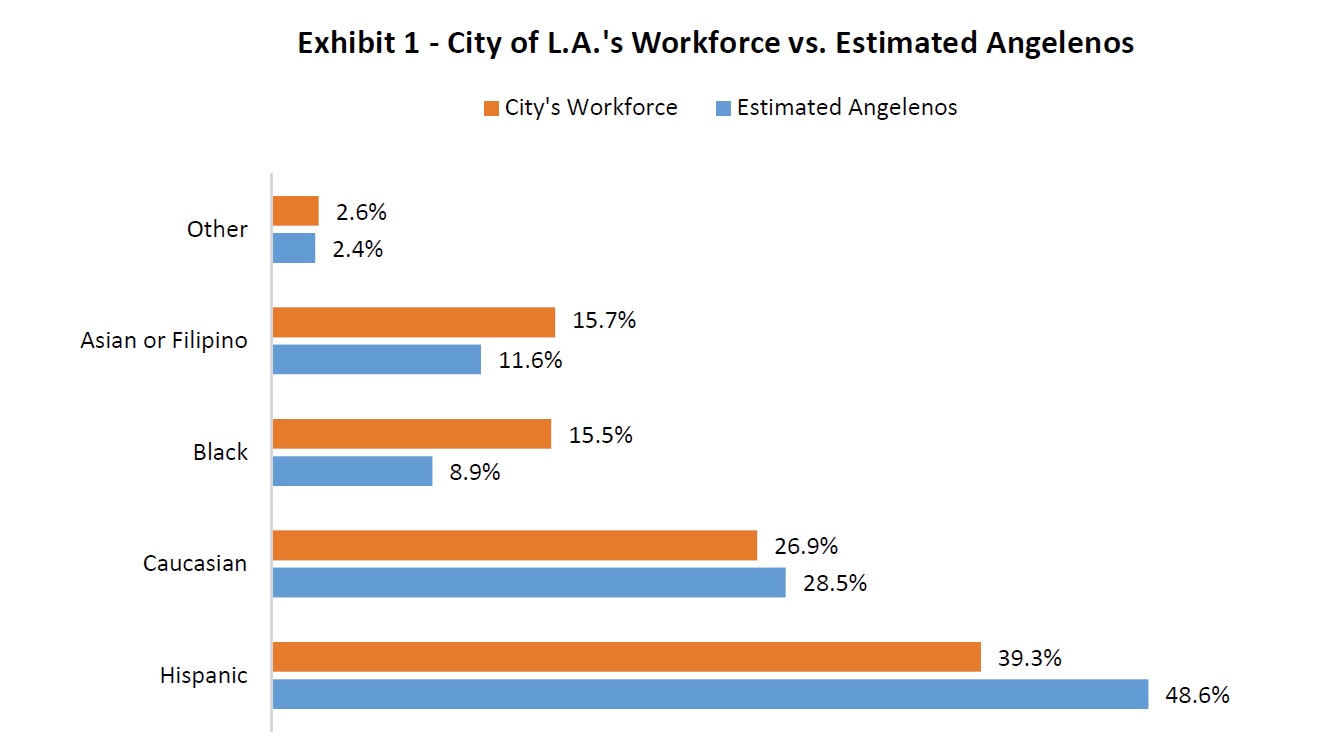 Sworn LAPD and LAFD Employees
Sworn LAPD and LAFD Employees
Sworn employees of the Police and Fire Departments may be the most visible of all the City’s public employees. Directly serving our community, sworn members of LAPD and LAFD comprise 26% of the total workforce.
The racial composition of sworn employees at the Los Angeles Police Department (LAPD) almost mirrors that of the City’s residents. The City’s Personnel Department has devoted significant efforts to attract a more diverse applicant pool for sworn positions at LAPD, and in September 2020 LAPD reported having its most diverse recruit class in its history.
 At the Los Angeles Fire Department (LAFD), almost half of all its sworn members are Caucasian. In 2014, the City removed two prerequisites that had been required prior to applying for the firefighter job classification (although the EMT certification and Physical Ability Test are still required before starting employment); this has reportedly helped provide a more diverse applicant pool. Further, after a firefighter applicant passes a cognitive and soft skills test, the Personnel Department uses a stratified random sampling methodology based upon combinations of gender and race to determine the applicants who go on to the next step, which results in maintaining a similar representation of applicants through the entire hiring process. It has been widely acknowledged that continued efforts are necessary to help increase the gender and racial diversity within LAFD.
At the Los Angeles Fire Department (LAFD), almost half of all its sworn members are Caucasian. In 2014, the City removed two prerequisites that had been required prior to applying for the firefighter job classification (although the EMT certification and Physical Ability Test are still required before starting employment); this has reportedly helped provide a more diverse applicant pool. Further, after a firefighter applicant passes a cognitive and soft skills test, the Personnel Department uses a stratified random sampling methodology based upon combinations of gender and race to determine the applicants who go on to the next step, which results in maintaining a similar representation of applicants through the entire hiring process. It has been widely acknowledged that continued efforts are necessary to help increase the gender and racial diversity within LAFD.
The City’s Personnel Department supports most City Departments and Offices in their recruitment of open (typically entry-level) job classifications. When a civil service job application is offered, the Personnel Department evaluates the gender and race of employees within the current job classification to determine if there is a need to develop a Targeted Recruitment Plan, which can include additional advertising through various professional and trade associations and organizations.
Diversity and Gender in the City’s Workforce
A further breakdown to show diversity by gender is presented below. Among women, there are proportionately more Black and Asian employees, while among men there is a higher proportion of Caucasian and Hispanic employees.
 Diversity Among City Functions and Largest Departments
Diversity Among City Functions and Largest Departments
The City classifies its personnel and budgetary information into nine broad functions: Protection of Persons and Property; Business Type Activities; General Government; Public Works; Health & Sanitation; Cultural & Recreational Services; Transportation; Community Development; and Retirement/Pensions. There are notable distinctions in race by City function, as compared to census data:
- Hispanic and Caucasian employees have the highest representation (32% and 43% respectively) within the protection of persons and property function;
- Black employees have the highest representation (31%) within the transportation function;
- Asian employees have the highest representation (40%) within the retirement and pension
The ten largest City Departments represent approximately 80% of the City’s total workforce. When comparing the race of employees working in these Departments to the total workforce and to census data, a few notable distinctions emerge: Public Works – Street Lighting has the lowest representation of Black employees at 6%, which is lower than the estimated 9% of Black Angelenos; while Airports and Transportation have the highest representation of Black employees at 31% each. LAFD has the highest representation of Caucasian employees at 46%, which is more than the 27% of Caucasian employees on the City’s workforce and the 28% of estimated Caucasian Angelenos.
Appendix I provides the demographics of all full-time employees working in each City Department.
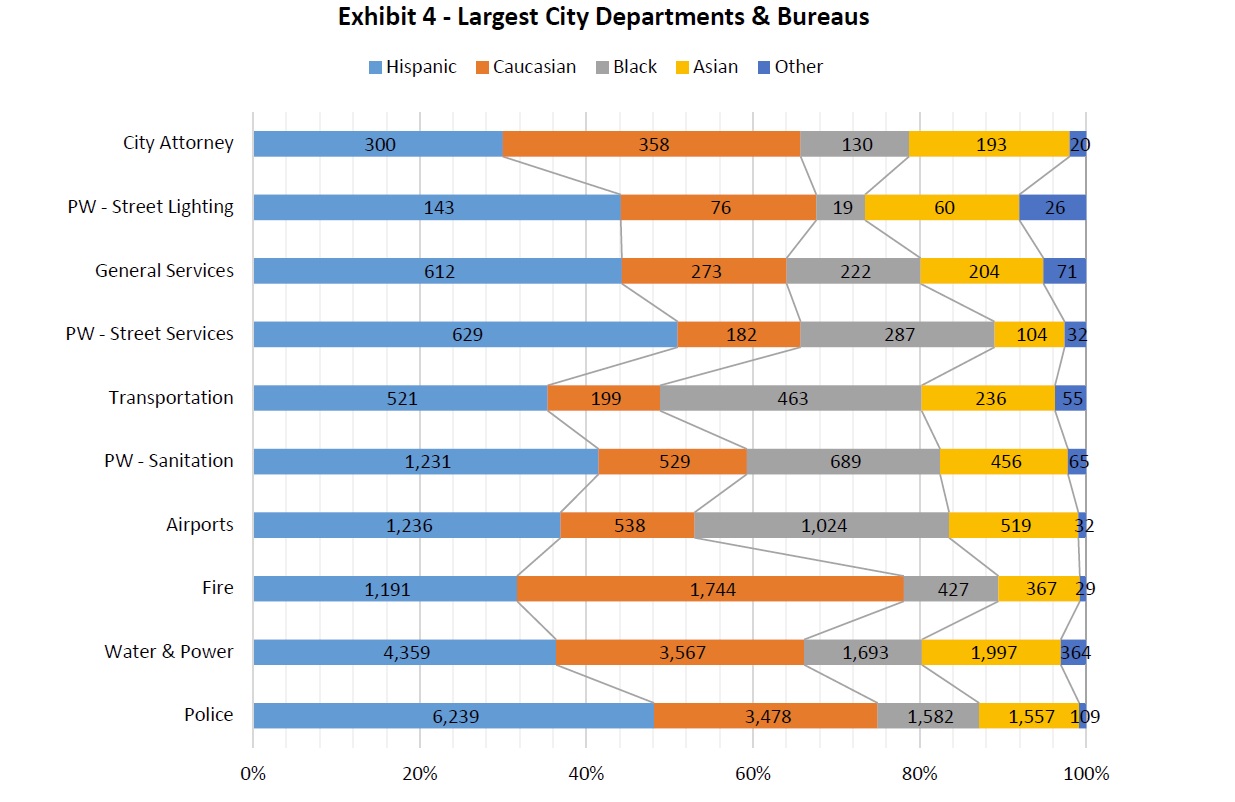 Years of Service
Years of Service
Among employees with fewer than five years of service, there appears to be more diversity than the rest of the workforce. While Caucasian employees represent 27% of the total City workforce, they comprise 23% of newer employees, but 34% of the longest-term City employees. This seems to indicate that the workforce has become more diverse in recent years.

When separately evaluating sworn employees, LAPD’s diversity has also been increasing in recent years, though for LAFD, diversity based on years of service appears less consistent.
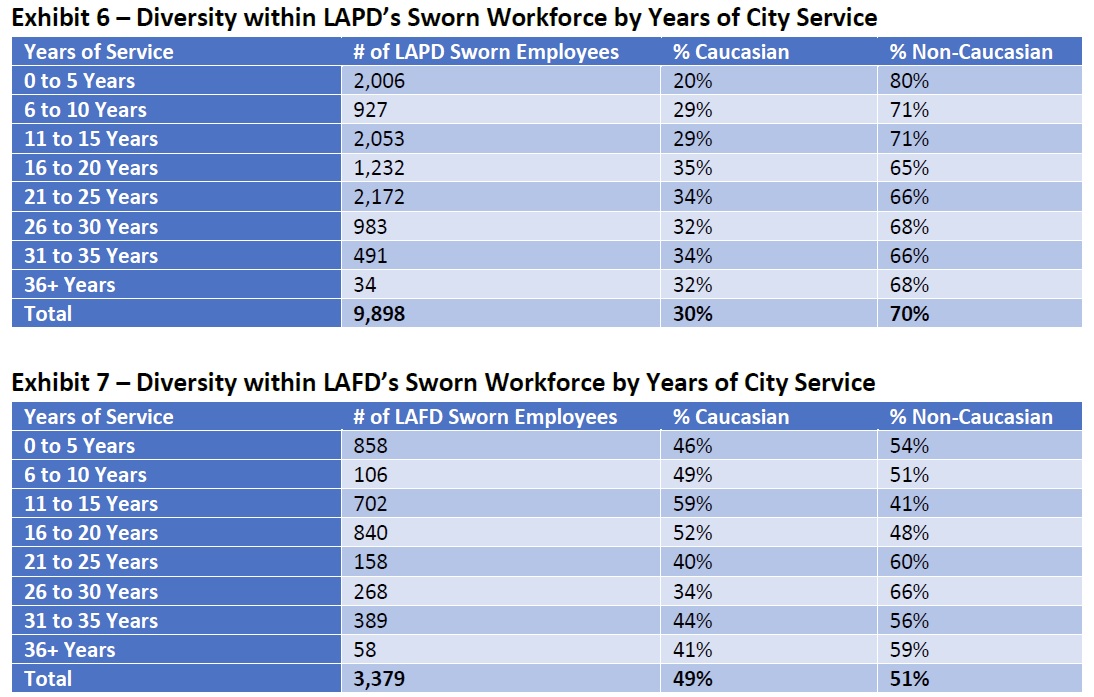 Point in Time Counts – Diversity over Two Decades
Point in Time Counts – Diversity over Two Decades
We measured the ratio of non-Caucasians, referred to here as People of Color, within the City’s workforce for four periods, July of 2005, 2010, 2015 and 2020. By comparing the racial composition for all full-time employees, we see there has been a steady increase in the ratio of employees who identify as People of Color, from 65% in 2005 to 73% in 2020. This is been especially prevalent among the sworn ranks of LAPD, which has risen from 57% to 70% over fifteen years, while there has been a small increase among the sworn members of LAFD.
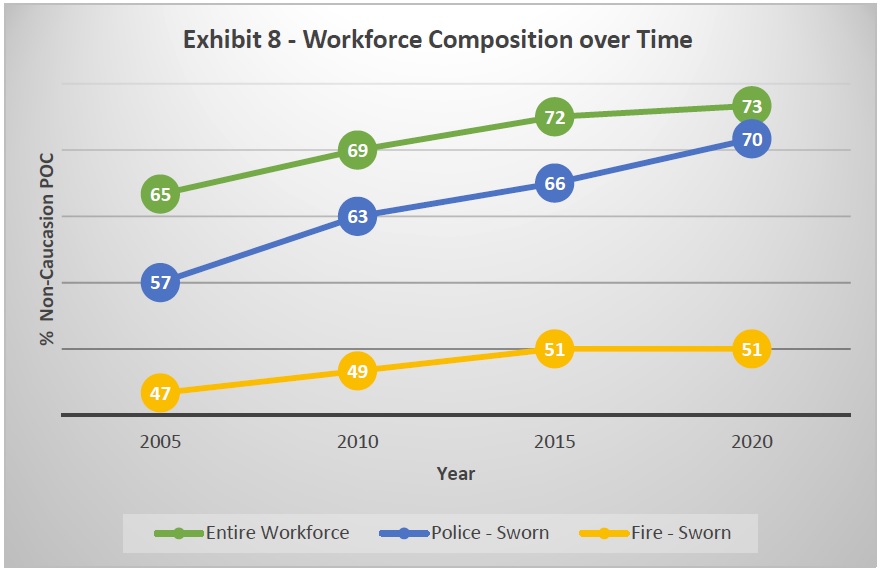
Pay Rates
City employees, on average, earn $48 per hour. However, when evaluating the average pay rate by racial group, Black employees and employees that identify as being another ethnicity (i.e., other, unknown, two or more races, or American Indian) have the lowest average hourly rates, while Caucasian and Asian employees have the highest average hourly rates.
When further evaluating average hourly pay by gender, women are paid less than men of the same race in all categories.

About 90% of all full-time City employees earn between $50 and $75 per hour. However, by examining those in classifications with the lowest pay rates (<$25/hour) and those at the highest (>$101/hour), we see notable differences with Hispanic and Caucasian groups:
- Hispanic employees are 39% of the workforce; and account for 54% of those earning the lowest rates, and 17% of those at the highest rates.
- Caucasian employees are 27% of the workforce, and account for just 9% of those earning the lowest rates, but 54% of those at the highest rates.
- The remaining groups are within seven percentage points of their overall proportion of the workforce.
 Each job classification has an established hourly pay range that is agreed upon with employee labor unions. All City employees holding a similar job classification are paid within the same hourly pay range regardless of gender or race (placement within the range is determined by years of service within the job class). That said, there is less diversity within jobs with the highest pay rates.
Each job classification has an established hourly pay range that is agreed upon with employee labor unions. All City employees holding a similar job classification are paid within the same hourly pay range regardless of gender or race (placement within the range is determined by years of service within the job class). That said, there is less diversity within jobs with the highest pay rates.
There are about 500 employees in job classifications making more than $101 an hour; these include several high level Office of the City Attorney job classifications, assistant and general manager job classifications, and elected officials. These positions are salaried, and thus are not eligible to earn overtime.
There are about 3,000 employees in job classifications making $25 or less per hour; these include council aides, accounting clerks, custodians, gardener caretakers, maintenance laborers, management assistants, administrative clerks, security officers, and traffic officers.
While the City has hundreds of job classifications, forty-one positions each have at least 200 employees, which collectively comprise 58% of the total workforce. Appendix II presents the demographic data, including average wage rates, for the City employees occupying those positions.
Gross Pay Analysis
An employee’s gross pay includes their regular hourly pay, bonuses, overtime, any adjustments that occurred during the year, and any payments for accrued leave at termination. Due to the significant additions to pay through overtime and other supplemental pay, only 20 of the Top 100 Earners in 2019 were employees who were paid at the highest hourly rate (>$101/hour).
Of the 100 highest paid City employees, 56 are Caucasian, while 21 are Hispanic, 15 are Black, and 8 are Asian. As reported in our Gender Equity report, only two of the top 100 were women; both are women of color (non-Caucasian) at the General Manager level. See Appendix III.
During FY 2020, the City’s full-time employees received $6 billion in gross pay. We analyzed data based on overall proportion of gross amounts paid to different groups and compared the average amounts paid to individuals within race and gender categories.
Workforce employee counts, like census data, are based on a point in time, while gross pay is presented over a period of time. Comparing the composition of the City’s workforce (from Exhibit 1), to the allocation of the total amount paid to all full-time employees during FY 2020 shows just minor variances:
 To determine the average gross amount paid to individual employees, we must consider all employees who received any pay during FY 2020. Based on our analysis, City employees received an average of $112,417; however, when comparing average gross pay by racial category, disparities are clearly noted.
To determine the average gross amount paid to individual employees, we must consider all employees who received any pay during FY 2020. Based on our analysis, City employees received an average of $112,417; however, when comparing average gross pay by racial category, disparities are clearly noted.
Caucasian employees received the highest average pay, while Black employees and employees who identify as another ethnicity or race (i.e., unknown, American Indian, other, two or more races) received the lowest. By further delineating gross pay by gender, women averaged less across all groups, with the widest disparity between the genders among Caucasian and Hispanic employees. For example, Black women on the City’s workforce earned 25% below the average gross amount paid, while Caucasian men earned 21% above the average; the difference between the average pay for those two groups is $52,000.
 Paid Overtime
Paid Overtime
During FY 2020, about 39,000 City employees were paid overtime, totaling $876 million. The majority of this additional pay went to sworn employees of LAPD and LAFD and trade positions at LADWP. While the average overtime paid was $22,560, when further segmenting the analysis by the race and gender, we see that the average paid overtime is significantly higher for Caucasian men than that for women who identify as being Asian or another race (i.e., unknown, two or more races, American Indian, or other). A reasonable explanation is that significant overtime is typically earned by sworn members of LAFD and trade positions within LADWP, and both these employee groups include these include a higher proportion of Caucasian men.

City management strives to maintain a workforce that reflects the community we serve. Gender and racial diversity are valued in the workplace, as it encourages increased awareness of and respect for differing viewpoints; leading practices cite that this improves overall productivity, creativity, and performance.
This analyses shows that the City’s workforce is extremely diverse. The Personnel Department appears to be making great strides in recruiting to achieve more diversity, especially within LAFD’s and LAPD’s sworn workforce. The City should continue to monitor trends related to equity in the workforce and identify ways to promote diversity, especially for the higher level (and thus higher paid) City positions. These actions should include encouraging employee development through training and recognition, and supporting a healthy work environment that values diversity and does not tolerate discrimination or harassment.
The information presented in this report should be used by policymakers to:
- Instruct the Personnel Department and request the Chief Equity Officer to report to the Council relative to how the data in “Diversity with Equity: Achieving Fairness at the City of Los Angeles” will be used to inform and support current and future efforts by the City’s Racial Equity Task Force, to develop an action plan to further increase diversity in the City’s workforce and address the pay gap among employees of color.
- Instruct the City Administrative Officer and the Personnel Department, with the assistance of the Chief Equity Officer, to utilize the data in “Diversity with Equity: Achieving Fairness at the City of Los Angeles,” and report to Council with an assessment of whether there are disparate impacts along the lines of race in hiring and promotion, to identify where such impacts are occurring, and provide recommendations on how the City should address said issues.
- Instruct the Personnel Department to report to Council annually with an update of demographic information of the City’s full-time employees, including data related to workforce composition and average earnings by race and gender in order to measure the impact of City efforts to increase diversity and equity in the workforce. Further, instruct the Personnel Department to update and publish this information on the City’s website so that the information is regularly available to the public.
Appendix I: Workforce Demographics by Department

Appendix II: Top Job Classifications

Appendix III: Top 100 Earners of 2019
